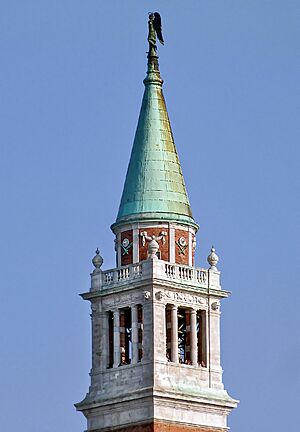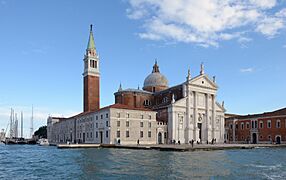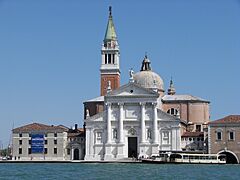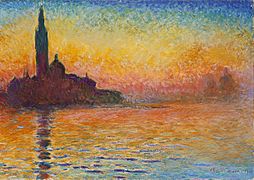San Giorgio Maggiore (church), Venice facts for kids
Quick facts for kids Church of San Giorgio Maggiore |
|
|---|---|

San Giorgio Maggiore opposite Riva degli Schiavoni
|
|
| 45°25′45″N 12°20′36″E / 45.4293°N 12.3433°E | |
| Location | Venice |
| Country | Italy |
| Denomination | Catholic |
| Architecture | |
| Architect(s) | Andrea Palladio |
| Architectural type | Church |
| Groundbreaking | 1566 |
| Completed | 1610 |
| Administration | |
| District | Patriarchate of Venice |
| Subdivision | Benedictine monks |
San Giorgio Maggiore (which means Saint George the Greater in Italian) is a beautiful church on an island in Venice, Italy. It was designed by a famous architect named Andrea Palladio. The church was built between 1566 and 1610.
This church is a basilica, which is a type of large and important church. It is built in the classical Renaissance style. Its bright white marble shines over the blue water of the lagoon. You can see it clearly from the Piazzetta di San Marco and the Riva degli Schiavoni.
History of the Church
The very first church on this island was built around the year 790. In 982, the island was given to the Benedictine monks by the Doge Tribuno Memmo. A Doge was like a ruler or duke of Venice.
The Benedictine monks built a monastery there. But in 1223, a big earthquake destroyed all the buildings on the island.
After the earthquake, the church and monastery were rebuilt. The church at that time was not in the same spot as the one you see today. It was further back, next to a small square. There were also courtyards in front of it, which were later removed in 1516. The monks started thinking about rebuilding the church again in 1521.
Andrea Palladio, the architect, came to Venice in 1560. At that time, the monks were rebuilding their dining hall, called the refectory. Palladio made many great improvements to it. In 1565, he was asked to create a design for a brand new church.
His design was finished and approved in 1566. The first stone of the new church was laid in the same year, with the Pope present. Palladio passed away in 1580, so he didn't see the church finished. However, most of the church building was complete by 1575. Only the choir, which is the area behind the altar, and the front of the church (the facade) were still unfinished. The inside decorations were added later.
The choir area was mostly designed by Palladio before he died. It was built between 1580 and 1589.
The church's front, or facade, was started much later, in 1599. The builders were told to follow Palladio's original design very closely. Only small changes were made. The facade was finally completed in 1610.
The campanile (bell tower) was first built in 1467. It fell down in 1774. It was rebuilt in a new classical style by 1791. You can go up the tower using easy ramps or a lift. From the top, you get a wonderful view of Venice!
Outside the Church
The front of the church, the facade, is very bright and white. It shows how Palladio solved a big problem for architects. He needed to make a classical temple front fit a Christian church. Churches usually have a tall central part (the nave) and lower side parts (the aisles).
Palladio's clever idea was to put two fronts on top of each other. One wide front covers the nave and both aisles. It looks like it's held up by simple columns called pilasters. On top of this, he put a narrower front, only as wide as the nave. This narrower front has giant columns that are attached to the wall.
On each side of the main entrance, there are statues. One is of Saint George, and the other is of Saint Stephen. The church is dedicated to both of them.
-
San Giorgio Maggiore at Dusk, a painting by Claude Monet
Inside the Church
The inside of the church is very bright. It has large columns and pilasters that are part of the walls. The walls themselves are plain and white. The church combines a long main hall (the nave) with a cross-shaped design (a cruciform plan) that includes side sections called transepts.
There are two very large paintings by Tintoretto that show scenes about the Eucharist. The Eucharist is a special Christian ceremony. These paintings are on either side of the presbytery, which is the area around the main altar. You can see them from the altar rail. The paintings are The Last Supper and The Jews in the desert. The second painting shows the Israelites collecting manna, a special food from God, after they escaped Egypt. This story is seen as a sign of the Eucharist.
In the Cappella dei Morti (Chapel of the Dead), there is another painting by Jacopo Tintoretto. It shows the Entombment of Christ, which is when Jesus's body was placed in a tomb.
The Benedictine monks who ran the church kept control of the chapels inside. They did not sell them to wealthy families to decorate as they wished, which was common in many other Venetian churches. The monks had their own money from property, so they were in a strong position. Some altars were given to important families, but the monks still decided how they would be decorated.
For example, the chapel to the right of the main altar belonged to the Bollani family. Work on this chapel was slow, and it wasn't finished until 1619. It had a simple painting as its altarpiece for a long time. In 1708, a very important painting called Virgin and Child with Saints by Sebastiano Ricci was finally placed there.
The altar to the left of the main area was for the Morosini family. This altar is dedicated to St. Andrew. The altarpiece, painted by Jacopo and Domenico Tintoretto, shows the Risen Christ and St Andrew with Vincenzo Morosini and members of his family.
The altars in the transepts (the cross-arms of the church) were kept by the monks themselves. In the south transept, there is a painting by Jacopo and Domenico Tintoretto called Coronation of the Virgin with Saints.
On the first altar on the right side of the nave, you can see Adoration of the Shepherds by Jacopo Bassano. On the left side, there is Miracle of the immobility of Santa Lucia by Leandro Bassano.
There are also other paintings located in the monastery building next to the church.
In Books and Comics
The church of San Giorgio Maggiore is mentioned in the famous novel A Passage to India by Edward Morgan Forster. In the book, a character thinks about how perfect Italian buildings like San Giorgio are.
Japanese artist Hirohiko Araki also features the church in his popular manga series JoJo's Bizarre Adventure, specifically in the Golden Wind story arc.
See also
- San Giorgio Maggiore (Monet series)
- History of early modern period domes
- List of buildings and structures in Venice
- List of churches in Venice















